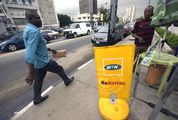THE recent surge in the oil price and recovery in Sasol’s shares has spurred an even greater, and harder to justify, appreciation in the price of Sasol Inzalo shares. Sasol Inzalo is largely funded by debt and this is not fully reflected in the share price.
Sasol Inzalo is a 10-year black economic empowerment (BEE) scheme established by Sasol in September 2008 and listed on the JSE in December. It has about 200,000 shareholders, who can sell only to other black people. Since mid-February, Sasol Inzalo’s shares have more than doubled to R50. In the same period, Brent crude has risen by a third and Sasol’s shares have added about 19%.
Sasol Inzalo has 16.1-million shares in issue. Its only asset is 16.1-million Sasol preferred ordinary shares that receive a cumulative preferred dividend.
This dividend is used to defray some of the scheme’s debt and pay operating costs.
Sasol Inzalo paid R5.9bn, or R366 a share, for its Sasol stake in 2008. It raised R371m from black shareholders, who paid R18.30 for their first 100 shares, and R36.60 for every subsequent share. The balance of the R366 a share was provided by external funders, secured by the Sasol shares and Sasol.
In September 2018, the preferred shares will convert to ordinary shares. Inzalo will sell enough preferred Sasol shares to discharge its debt and distribute any that remain to Inzalo shareholders on a pro rata basis.
If the sale of shares does not raise enough to repay its obligations, there will be no distribution and Inzalo will call on its guarantees. Sasol Inzalo’s prelisting statement explains that the value of its shares depends on the number and value of the Sasol preferred ordinary shares it owns, Sasol’s market price, prime interest rate and outstanding debt.
Sasol Inzalo’s financial statements for the six months to December show its Sasol shares were worth R6.7bn (the shares were R419.40 on December 31) and debt was about R7.2bn.
Its net asset value was a negative R600m, or R37 per share, and its tangible net asset value was a positive R27m, or R1.68 per share.
A lot can happen before September 2018, but the significant gap between the share price and tangible net asset value should raise some alarm bells.
Craig Gradidge, a financial adviser and co-founder of GM Investments, said he did not make recommendations on Sasol Inzalo shares, but they were held in many of the portfolios of his clients.
He did not believe any sophisticated modelling was being done on the underlying value for Sasol Inzalo shares, he said. The most relevant influence was seen as the price of Sasol’s shares in September 2018.
The market price of R49 could reflect optimism that Sasol’s share price would be higher by then, Mr Gradidge said. There was also speculation, or rather hope, that Sasol would do the same as Naspers did with its Welkom Yizani black economic empowerment (BEE) share scheme, he said.
Last month, Naspers said it would waive all the preference share debt and accrued interest the scheme owed it.
Hennie Christodoulou, corporate finance deal maker at Bravura Capital, said there was a lot of debate in financial circles about whether highly leveraged, special-purpose vehicles were best for BEE participation.
Financing 100% of assets with shorter-term debt was risky, because of the payment profile and terms of debt, and the volatility of equity returns.
In the short term, the value of equity could fall significantly below the value of debt, especially in a rising interest rate environment. In the long run, equity should outperform debt.
But if debt repayment fell due in the midst of market or stock-specific turmoil, BEE participants could end up with limited to zero value, he said.





















Change: -0.47%
Change: -0.57%
Change: -1.76%
Change: -0.34%
Change: 0.02%
Data supplied by Profile Data
Change: -1.49%
Change: 0.08%
Change: -0.47%
Change: 0.00%
Change: -0.04%
Data supplied by Profile Data
Change: -0.34%
Change: 0.03%
Change: -0.10%
Change: -0.22%
Change: -0.69%
Data supplied by Profile Data
Change: -0.28%
Change: -1.15%
Change: -0.07%
Change: -1.21%
Change: -0.22%
Data supplied by Profile Data